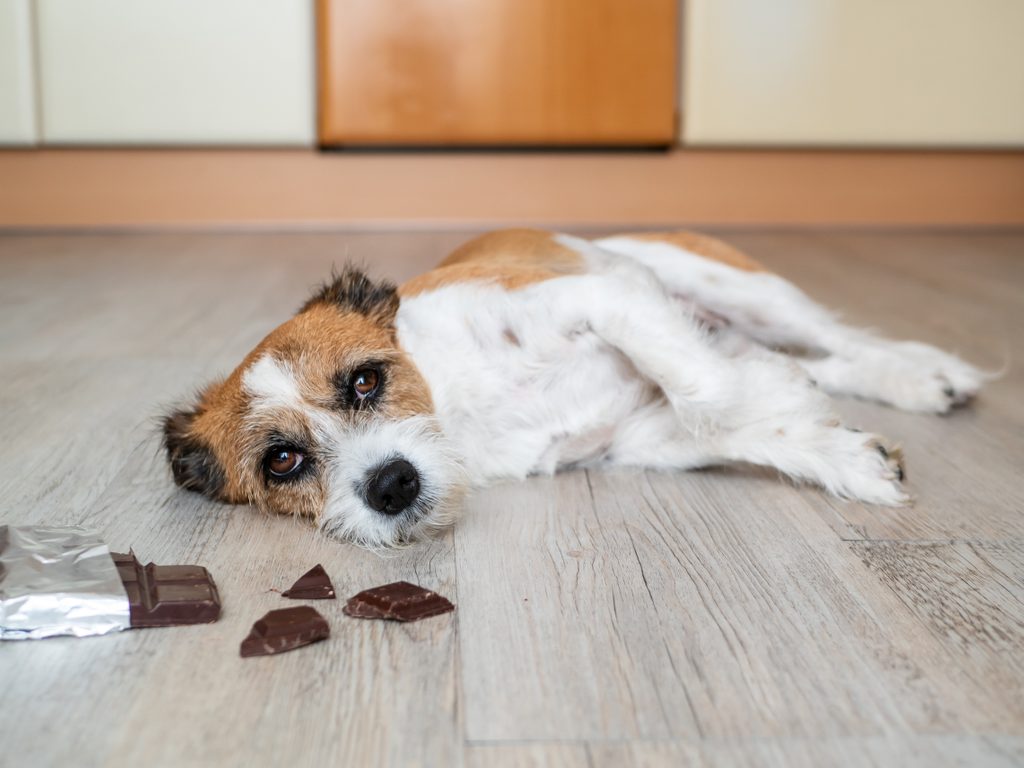What Happens When a Dog Eats Chocolate?
Updated: Apr. 25, 2021

Pay attention to this important information that could save your dog’s life. You never know when you might need it.
Chocolate may be an irresistible, delicious treat for humans, but all forms of this food are strictly off-limits for our canine companions. To help you understand why dogs can’t eat chocolate and what your best plan of action is if they do—including whether you should seek veterinary assistance immediately—we asked some experts to weigh in. Commit these facts to memory, just in case. They just might save your pup’s life someday.
Why chocolate is poisonous to dogs
Chocolate is toxic to dogs because it contains a chemical called theobromine, which is very difficult for dogs to metabolize, says Brendan Russi, DVM, a veterinarian at Banfield Pet Hospital. Chocolate also contains caffeine, which can cause restlessness and elevate heart rates. “In addition,” he says, “the fats and sugars contained in chocolate can wreak havoc on your pet, causing vomiting, diarrhea, and a painful and dangerous inflammation of the pancreas.” In very severe situations, canine chocolate consumption can cause seizures, coma, and even death. These are other common foods that could be toxic for dogs.
Are some types of chocolate worse than others?
While all forms of chocolate should be avoided, some types are technically more toxic than others. The general rule is that the purer the chocolate and the larger the quantity, the more toxic it is to dogs. For example, while a single milk-chocolate chip might not cause issues, a large piece of dark chocolate could lead to the symptoms outlined above.
“Pure cacao beans contain the greatest amount of theobromine, followed by cocoa powder, dark chocolate, and milk chocolate,” says Christie Long, DVM, a veterinarian for Modern Animal. “White chocolate, despite the name, doesn’t actually contain any chocolate, and things like chocolate-flavored snack bars or cakes don’t actually contain much chocolate, so usually we see only mild signs, if any, after a dog scarfs those up. Very minute quantities will likely be of no significance.”
How much chocolate is too much?
The straight answer to this question is that dogs shouldn’t consume any amount of chocolate—ever. However, Dr. Long explains that theobromine toxicosis is dose-dependent, meaning that the significance of the symptoms depends on the amount, per kilogram, ingested in relation to a dog’s body weight. In other words, a small dog is going to experience more symptoms than a large dog when the same size and purity of chocolate is consumed. Of course, food isn’t the only thing in your home that could pose a problem. These household items are also seriously hazardous for your pets.
Signs your dog has eaten chocolate
Since it’s impossible to keep your eyes on your pup 24/7, it’s possible for them to get their mitts on some chocolate without your knowledge. Signs of chocolate consumption include vomiting, diarrhea, restlessness, elevated heart rate, rapid or shallow breathing, and increased urination. More serious signs include shaking or tremors, seizures, and collapse. Here are more ways to know if your pet has food poisoning.
What to do if you think your dog ate chocolate
“If you suspect or know your pet has ingested chocolate, it’s important to consult a veterinarian or emergency hospital right away,” says Dr. Russi. “Early intervention can help to prevent some of the more severe problems.” Dr. Long adds that the ASPCA’s Poison Control hotline (1-888-426-4435) can help you determine whether your dog has consumed chocolate and what your best plan of action is, as well.
Should you induce vomiting?
Both veterinarians we spoke with recommend consulting your veterinarian or the ASPCA immediately if you suspect that your dog has eaten chocolate. Dr. Long says there is a window of about 90 minutes during which inducing vomiting will keep your dog from experiencing serious side effects, but this can be very difficult to accomplish without the assistance of a vet. “Veterinarians have special drugs that can be given intravenously that bring on rapid induction of vomiting, so it’s best to leave that job to the professionals,” she explains. “Plus, there can be quite a cleanup afterward, if successful.”
Also, taking matters into your own hands after a consultation with Dr. Google could actually make things worse. “Many people have heard that you can use hydrogen peroxide to make a dog throw up,” Dr. Long says. “This is true, but it can be extremely irritating to the esophagus and stomach, and I’ve seen dogs get sicker because of the hydrogen peroxide given by their owners than the sickness that would have been caused by what they ate.”
Here are another 20 things you’re probably doing that veterinarians wouldn’t.
Is a “wait and see” approach ever OK?
Our vets agree that a “wait and see” approach is not ideal when dealing with chocolate. “If you know your dog has eaten chocolate, you should act immediately,” says Dr. Long. “If the amount is significant—your veterinarian or the Pet Poison Helpline can help you determine this—it’s important to act urgently.”
The bottom line on canine chocolate consumption
It’s best to keep your dog away from all forms of chocolate, however small or “watered down” with other ingredients like sugar or milk. Symptoms can range from mild to severe, but it’s never worth the risk. If you suspect or know that your dog ate chocolate, your best plan of action is to high-tail it to your preferred vet or a local veterinary hospital—whichever is closest. Next, find out the 10 signs your “healthy” pet is showing illness symptoms.


